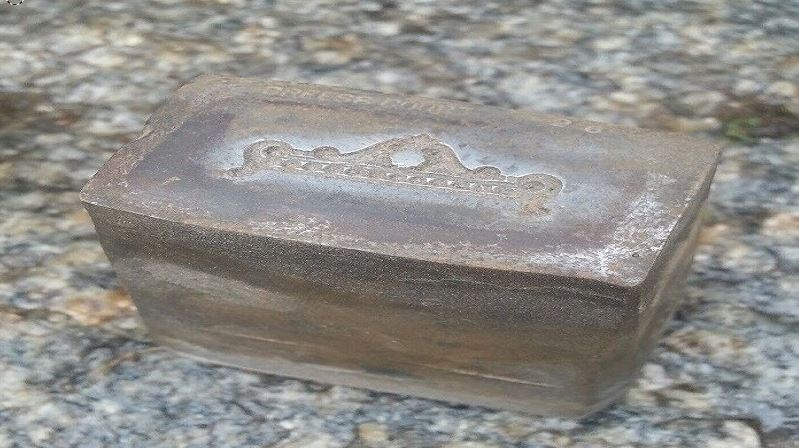
22 Aug Hubs and Dies- A Closer Look Into the Findings at Fowler Clark Epstein Farm
In the course of restoring the Fowler Clark Epstein Farm, HBI’s contractors found a series of jewelry hubs and dies in the property’s barn.Guest blogger, Laura E. Johnson, Associate Curator at Historic New England, took a look at them and tells us what they are and how they might have worked.
Recent work at the Fowler-Clark-Epstein farm uncovered a series of jewelry tools.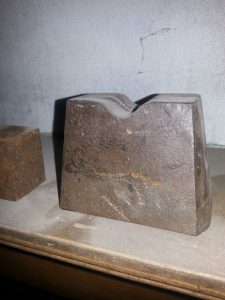 The last owner of the property, Jorge Epstein, was a jewelry designer before he began to buy and sell architectural salvage. The jewelry tools, which were made between 1880 and 1920 in Providence, Rhode Island, are hubs and dies once used for making stamped metal jewelry.
The last owner of the property, Jorge Epstein, was a jewelry designer before he began to buy and sell architectural salvage. The jewelry tools, which were made between 1880 and 1920 in Providence, Rhode Island, are hubs and dies once used for making stamped metal jewelry.
Mass-produced jewelry is typically created through one of two methods: casting or stamping. Cast jewelry is made from hot metal, plastic, or glass poured into a mold, similar to a cake baking in a tin. Stamped jewelry is made by pressing a ribbon of metal down into a form called a die. Dies are the negative version of the master, called a hub. A die sinker drives a hub into steel to make a die think about pressing a door key into wax or clay. The wax impression is the negative and the key itself is the master. Dies are the working models used to produce the final product. A die can make hundreds of pieces before it is too worn to make a clear image any longer. The steel hub shown to the right is not from the Epstein collection. It was cut by Providence-based Coro (operating from 1901-79). It is shown below a stamped, gold-plated brooch. Note the spaces left in the hub for stones set in the eyes and tail of the brooch.
Made from steel that has since rusted, the only hub in the Epstein collection depicts a young woman with her hair up in a Gibson-style topknot. The dies made from this hub would have been used to produce stamped metal cameos. The remaining pieces are all dies, or impressions made from a hub.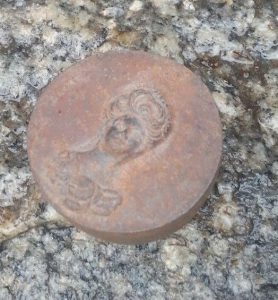
The die below is for a ring, which would have been stamped out and then soldered together. The circle in the center would have been set with a decorative stone. I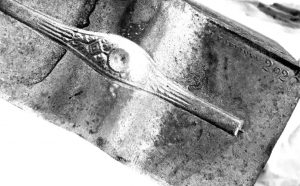 t bears the marks of L.E.
t bears the marks of L.E.  Jelinek and WHM & Sons. Louis E. Jelinek worked as a die-sinker in the 1890s and early 1900s. His mark is visible at the top right of the block face, enlarged and enhanced in the photograph to the right. William H. Miller & Sons (their mark is on the side of the block) worked primarily as blacksmiths in the 1880s, but also made dies, hubs, and other tools of the jewelry trade.
Jelinek and WHM & Sons. Louis E. Jelinek worked as a die-sinker in the 1890s and early 1900s. His mark is visible at the top right of the block face, enlarged and enhanced in the photograph to the right. William H. Miller & Sons (their mark is on the side of the block) worked primarily as blacksmiths in the 1880s, but also made dies, hubs, and other tools of the jewelry trade.
Crees & Court (their name is at the top left) were die-cutters and tool makers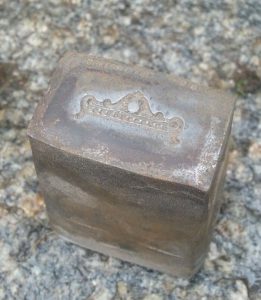 . They made dies from the 1880s to at least the 1910s. The die to the left is for a small purse clasp. Standard Machinery Company (marked on the side of the die) produced a wide range of presses and jewelry machinery.
. They made dies from the 1880s to at least the 1910s. The die to the left is for a small purse clasp. Standard Machinery Company (marked on the side of the die) produced a wide range of presses and jewelry machinery.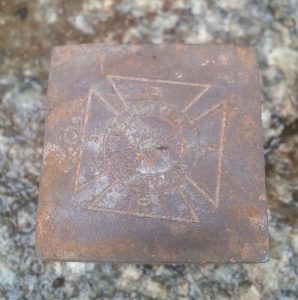
A version of the badge used by the Massachusetts Catholic Order of Foresters, the first Catholic fraternal insurance organization in Massachusetts, was engraved in an unmarked and unfinished die that dates to the 1880s or 90s. Founded in 1879, the organization is still in operation today.
A tiny charm bears marks of an unidentified die sinker and its material, duro-steel, stamped at the top. 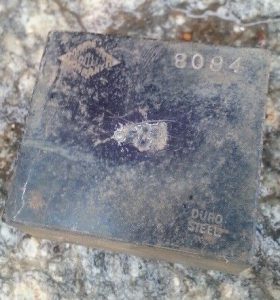
The manufacturing jewelers who commissioned these dies did not mark them with their own names, nor in many cases did they mark the jewelry they made. Hubs and dies are often the only way jewelry historians can connect manufacturers to the jewelry they created. While it is unlikely that Mr. Epstein ever used these dies, he helped preserve an important part of New England’s history of jewelry production. Among the archival collections of Historic New England are metal jewelry samples, an inventory book, and original designs by Epstein from the 1930s. It is possible that these dies formed part of that collection at one time. For more on Historic New England’s collection, please visit HistoricNewEngland.org.
Visit Historic New England’s jewelry exhibition, Mementos: Jewelry of Life and Love, at the Eustis Estate in Milton, Massachusetts through January 7, 2018.



